
Limnodynastes dumerilii is a frog species from the family Limnodynastidae. The informal names for the species and its subspecies include eastern or southern banjo frog, and bull frog. The frog is also called the pobblebonk after its distinctive "bonk" call, which is likened to a banjo string being plucked. There are five subspecies of L. dumerilii, each with different skin coloration. The species is native to eastern Australia. There has been one occurrence in New Zealand, when tadpoles of the species were found in 1999 and destroyed.

The giant burrowing frog or eastern owl frog is a large frog species that occurs in coastal south-east New South Wales and Victoria in Australia. It is also known as the owl frog, southern owl frog, spotted owl frog, burrowing owl frog.

The eastern dwarf tree frog, also known as the eastern sedge-frog, is a species of tree frog. It is a small and very common frog and found on the eastern coast of Australia, from around Cairns, Queensland, to around Ulladulla, New South Wales. Individual frogs of this species are often found elsewhere, having been accidentally relocated by transported fruit boxes. Confirmed sightings of breeding pairs have confirmed their survival in Victoria's cooler climate.
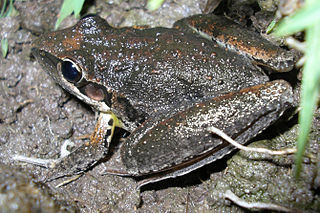
The broad-palmed frog is a species of ground-dwelling tree frog. It is native to much of eastern Australia. They can be found from mid-Queensland to south of Sydney. It is associated with the coast and inland, and is distributed as far west in New South Wales to the South Australia border.

Freycinet's frog, also known as the wallum rocket frog, is a species of frog. It inhabits coastal areas from Fraser Island, Queensland, south to the Jervis Bay Territory of New South Wales.
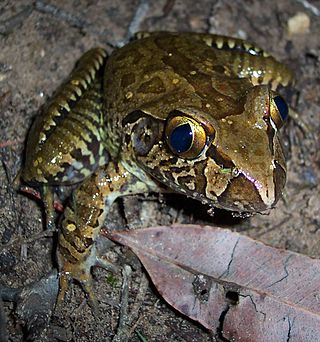
The giant barred frog is a species of barred frog found in Australia. It occurs from south-eastern Queensland to just south of the Newcastle region in New South Wales. It is associated with flowing streams and creeks in wet sclerophyll and rainforest habitats from the coast to the ranges.

The Tasmanian froglet is a species of ground-dwelling frog that occurs only in Tasmania, Australia.

The red-crowned toadlet is a species of Australian ground frog, restricted to the Sydney Basin, New South Wales. It is only found around sandstone escarpment areas around Sydney, from Ourimbah in the north, Nowra to the south and the Blue Mountains areas to the west.

The leaf green tree frog is a species of stream-dwelling frog, native to eastern Australia from the Queensland/New South Wales border south to Sydney.
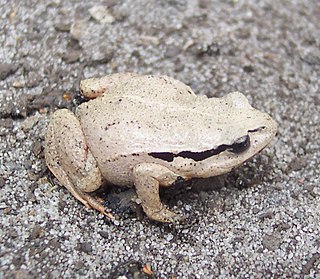
Haswell's frog is a small ground frog found around coastal swamps in eastern Australia from around Port Macquarie, New South Wales to the Mornington Peninsula in Victoria. It is the only member of the genus Paracrinia.

Pearson's green tree frog, also known as the cascade tree frog, is a species of tree frog inhabiting rainforest creeks from north of Lismore, New South Wales, to Kenilworth, Queensland, with a disjunct population at Kroombit Tops Queensland, Australia.

The stuttering frog is a large species of frog that inhabits temperate and sub-tropical rainforest and wet sclerophyll forest in Australia.
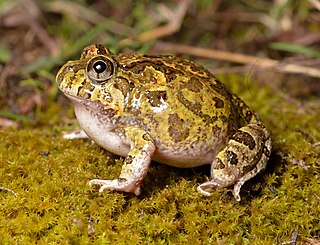
The ornate burrowing frog is a species of ground frog native to Australia. It was moved to the genus Opisthodon in 2006, following a major revision of amphibians, and is now classified in the genus Platyplectrum.

Littlejohn's tree frog, also called a heath frog or orange-bellied tree frog, is a species of tree frog native to eastern Australia from Wyong, New South Wales, to Buchan, Victoria.

The Sudell's frog, painted burrowing frog, trilling frog or desert trilling frog is a species of burrowing frog common to a large part of southeastern Australia. It is found on and west of the Great Dividing Range of New South Wales to western Victoria and southern Queensland, as well as far eastern South Australia, and southern regions of the Northern Territory.

The New Holland frog, also known as wide-mouthed frog, is a large species of burrowing frog native to northern New South Wales and the eastern portion of Queensland, Australia.

The salmon-striped frog is a species of ground dwelling frog native to southeastern Queensland and northern New South Wales, Australia.
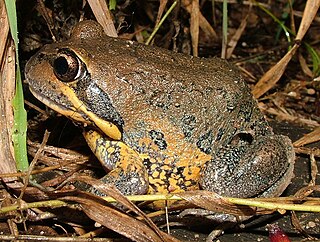
The Northern banjo frog is a species of ground-dwelling burrowing frogs native to eastern Queensland and northeastern New South Wales, Australia.

The large toadlet or great toadlet or major toadlet is a species of ground-dwelling frog native to eastern Queensland and northern New South Wales, Australia.

The long-thumbed frog, Fletcher's frog or barking marsh frog is a species of non-burrowing ground frog native to south-eastern Australia. The species belongs to the genus Limnodynastes. The twelve species in the genus are characterised by a lack of toe pads. Following phylogenetic analysis, the species was placed in L. peronii clade group alongside L. depressus, L.tasmaniensis and L. peronii.






















